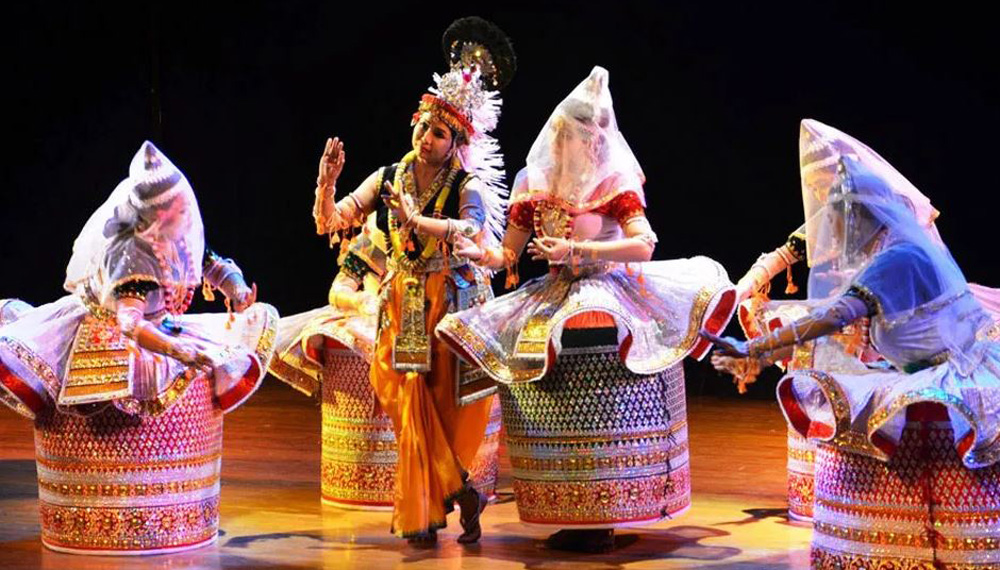
Manipuri dance, one of the main styles of Indian classical dances, traces its origins to times beyond recorded history. The dance is intricately linked with religious rituals, and legends of gods and goddesses, particularly Shiva and Parvati, weave into the vibrant fabric of Manipuri culture. The Lai Haraoba festival, a ceremonial offering of song and dance, remains a living testimony to the earliest form of Manipuri dance, rooted in the pre-Vaishnavite period. With the advent of Vaishnavism in the 15th century A.D., Manipuri dance witnessed a transformation. The introduction of compositions inspired by the life of Radha and Krishna, coupled with the visionary contributions of King Bhagyachandra in the 18th century, gave birth to the popular Rasleela dances. Each successive ruler added new dimensions, iManipuri dance, also referred to as the Manipuri Raas Leela (Meitei: Jagoi Raas/Raas Jago is a jagoi and is one of the major Indian classical dance forms, originating from the state of Manipur. It is one of the greatest cultural achievements of the traditional Vaishnavism adhering Meitei people of Manipur. Owing to the Meitei civilization,[10] the classical dance form, first formally developed by Meitei Hindu king Ching Thang Khomba (Meitei for ‘Rajarshi Bhagyachandra’) of the Kingdom of Manipur, is considered to be the highest spiritual expression of the worship of Hindu deity Krishna. Owing to its huge influences on the diverse cultural heritages across the Indian subcontinent, it is recognised by the Sangeet Natak Akademi of the Ministry of Culture of the Government of India as one of the few primary classical dance forms of the Republic of India,and is honoured with the Sangeet Natak Akademi Award for Manipuri annually. It is referred to as the “national dance” during the Armenia-India joint issue of postage stamps, as a part of the Armenia-India international relations.
It is imbued with the devotional themes of Madhura Raas of Radha-Krishna and characterised by gentle eyes and soft peaceful body movements. The facial expressions are peaceful mostly expressing Bhakti Rasa or the emotion of devotion, no matter if a dancer is Hindu or not. The dance form is based on Hindu scriptures of Vaishnavism and is exclusively attached to the worship of Radha and Krishna. It is a portrayal of the dance of divine love of Krishna with goddess Radha and the cowherd damsels of Vrindavan, famously known as the Raas Leela.
The roots of the Manipuri Raas Leela dance, as with all classical Indian dances, is the ancient Hindu Sanskrit text Natya Shastra, with influences and the culture fusion between various local folk dance forms.[19] With evidence of Vishnu temples in the medieval era, this dance form has been passed down verbally from generation to generation as an oral tradition.[20][21] At a time when other Indian classical dances were struggling to shake off the stigma of decadent crudity and disrepute, the Manipuri classical dance was a top favorite with girls of ‘respectable’ families.
This Manipuri dance drama is, for most part is entirely religious and is considered to be a purely spiritual experience.[22][23] It is accompanied with devotional music created with many instruments, with the beat set by cymbals (kartal or manjira) and double-headed drum (pung or Manipuri mrdanga) of sankirtan.[24] The dance drama choreography shares the plays and stories of Vaishnavite Padavalis, that also inspired the major Gaudiya Vaishnava-related performance arts found in Assam and West Bengal.
Though the term Manipuri Dance is associated with the Raas Leela, Manipuri dance consists of jagoi, cholom and huyen langlon.ntroducing leelas and rhythmic compositions that enriched the dance form. Manipuri dance boasts a diverse repertoire, with Ras, Sankirtana, and Thang-Ta being among the most popular forms. The Ras dances, depicting the eternal love of Radha, Krishna, and the gopis, are characterized by lyrical and graceful movements. The parengs, or pure dance sequences, follow specific rhythmic patterns, with the Ras costume itself being a masterpiece of rich embroidery and unique design. The dance form is not merely a visual spectacle; it transcends into a spiritual experience. The emphasis on facial expressions in Manipuri dance allows performers to convey deep emotions and narratives. Themes often revolve around the poignant separation of the gopis and Radha from Krishna, creating a captivating and emotionally charged performance. The musical accompaniment to Manipuri dance is equally enchanting. The Nat style of singing, distinct from North and South Indian music, complements the high-pitched open-throated rendering with unique trills and modulations. The Pung, a classical drum, takes center stage, accompanied by various other instruments like the Pena and flute, creating a harmonious blend of sound and movement. Known for its subtleness, Manipuri dance does not employ ankle bells for rhythmic display, allowing the delicate body movements to take precedence. The dance’s abhinaya, or expression, is marked by natural facial expressions, and sarvangabhinaya, using the entire body to convey emotions, remains a forte. Manipuri dance, rooted in the ancient Sanskrit text Natya Shastra, has a history that dates back to the early 18th century. Despite challenges during the British colonial period, the dance form survived in temples, later experiencing a revival through the efforts of Rabindranath Tagore in the modern era.